Learning about learning
|
About five years ago I attended a higher ed workshop where the panelists introduced MOOCs (Massive Online Open Courses) and were discussing their potential impact on higher ed. There was a note of panic in their voices, because, after all, MOOCs are free and the mooc providers were "giving learning away", which might interrupt the revenue stream (read cash cow) in higher ed. The MOOC providers continued to publish, and the learners kept learning. You can read some interesting stats about them in Class Central's 2015 analysis of MOOC trends. Who's Taking Them and What are people learning in MOOCs?
What can we learn from MOOCs?There are some big lessons for us as designers around the popularity of the MOOC.
Where do I start? Where can I find MOOCs I'd be interested in?
There are also a new breed of low cost MOOC-like courses created and offered by individual "experts" that are worth checking out. The quality varies more here, but for the most part, I've found them to be pretty good. There are subscription based services like Skillshare, and inexpensive pay-per-course based offerings through Udemy and Craftsy. You can go high end and enroll in the offerings of Lynda.com if you have a bit of a budget. I've found their work to be exceptional, and targeted well to our needs as instructional designers. There's lots to learn out there! What are you waiting for? References
0 Comments
Leave a Reply. |
Jean Marrapodi
Teacher by training, learner by design. Archives
January 2018
Categories
All
|
Conference
|
Company
|
|


 RSS Feed
RSS Feed